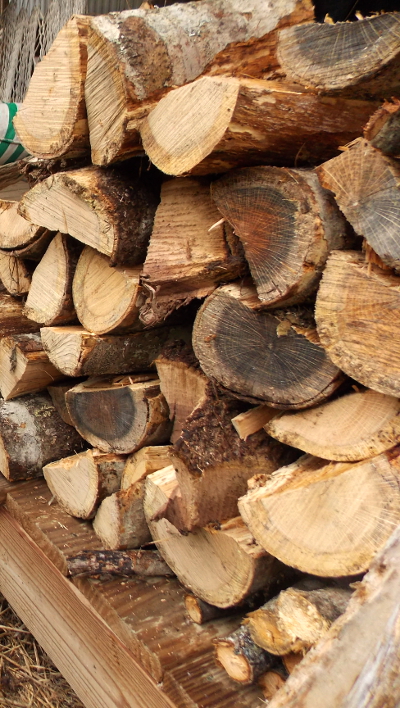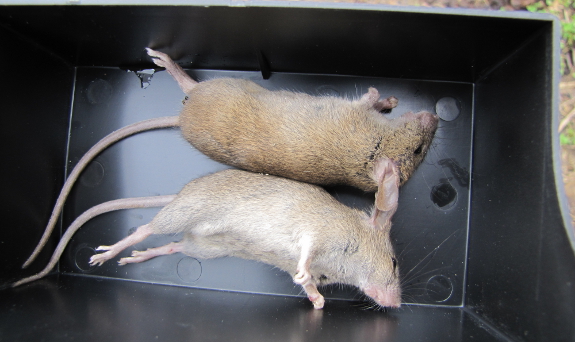
Two thorny homesteading issues
 "I was wondering whether this feels like it might be a longer winter
than normal and if the woodshed was full enough to make it through to
the warmer weather of spring? In our two years having a woodstove at our
cabin, we are still learning just how much wood we will need to keep us
warm during the cold months.
"I was wondering whether this feels like it might be a longer winter
than normal and if the woodshed was full enough to make it through to
the warmer weather of spring? In our two years having a woodstove at our
cabin, we are still learning just how much wood we will need to keep us
warm during the cold months.
Also - I was curious if you have to deal with mice in the trailer?
Our cabin was invaded recently and I was looking for more good ideas to
make them less inclined to visit."
--- Karen B.
Two great questions, Karen!
As for the wood --- we never seem to have quite enough, but we manage.
In order to really get ahead on firewood, we'd need to change our system
so that we can stock up on wood during the winter that comes a year
before we plan to burn it,
since that's a season when our lives are less busy. But since I need to
be able to get to last year's firewood during the winter, we instead
empty the woodshed out and then fill it back up. In the end, that method
means that cutting firewood has to compete with the garden --- I'll bet
you can guess which one wins! To make up for our slacker habits, I tend
to earmark a standing dead tree
or two for spring firewood since the dry wood can often be burned soon
after cutting, which generally ekes us through late February, March, and
April.

The mouse issue is more
interesting to me because we're finally starting to figure it out. Every
fall, the local mouse population does
tend to invade our trailer, and even though Huckleberry catches an
occasional mouse, he's not our first line of defense. (Our other cat,
Strider, is a lover, not a fighter.) We've learned the hard way that
it's essential to be hyper vigilant at this time of year --- at the
first sound of nibbling in the walls or sight of mouse droppings on the
counter, we pull out the traps with a vengeance. Mark talked me into
buying this super fancy trap
years ago, and it did work for a little while (as you can see above),
but then the scent of death built up and the mice started to avoid it.
Now, we tend to use cheaper traps, which we can reuse a few times until
they lose efficacy and then toss. Our favorite trap is currently one a lot like this.
When trapping mice, you'll
want to put the trap where you think a mouse might run. Mice are
skittish little varmints, so they're unlikely to head to your bait in
the middle of the floor; instead, set your trap against a wall in an
out-of-the-way spot (but near where you saw their signs). We sometimes
bait with peanut butter, but cheese has a higher success rate,
especially cheddar. I probably don't need to say it, but don't bother
with live traps --- moving animals around is never a good idea, and
unless you live way out in the country, the mouse is likely to head into
another home after you release it, where it will get killed anyway.
Another factor to keep in
mind is sealing away anything that a mouse might like. Food is obvious,
but clothing and toilet paper are also in great demand for bedding. An
average bureau doesn't really keep a mouse out, I've found, so
rubbermaid bins can sometimes be better. Barring that, I try to at least
go through each drawer on occasion so I don't miss a mouse nest being
built. If you have storage areas inside your home, don't pile things up
in such a manner that a cat can't get into the center to hunt, and do
check those little-used areas at intervals as well. Catching the first
few mice who drop by in the fall is only of middling difficulty, but if
you let them breed and have fifty mice to hunt down, your work will
really be cut out for you!
I hope that helps, and I'm
glad you're being proactive. In the city, roaches are probably the most
common vermin, but in the country, it's all about beating the mice. And
as cruel as it seems to kill them off in the fall, you'll be rewarded by
a winter sitting by the fire without the sound of nibbling in the
walls.
Want more in-depth information? Browse through our books.
Or explore more posts by date or by subject.
About us: Anna Hess and Mark Hamilton spent over a decade living self-sufficiently in the mountains of Virginia before moving north to start over from scratch in the foothills of Ohio. They've experimented with permaculture, no-till gardening, trailersteading, home-based microbusinesses and much more, writing about their adventures in both blogs and books.
Want to be notified when new comments are posted on this page? Click on the RSS button after you add a comment to subscribe to the comment feed, or simply check the box beside "email replies to me" while writing your comment.

My philosophy toward wildlife is "live and let live", until they are interfering with my living. When they contaminate my food, destroy my belongings, that are rightfully stored in my personal home, then the gloves are off. I do not seek out and destroy their personal living spaces in nature, and I will not accept them intruding on my personal living space. I too believe in clean killing of mice, when the weather turns colder and they decide my home looks like a great place for a winter vacation. We use very large glass jars, and freezers to store food, so that there is little sustenance available to beings who do not respect the boundaries of our home. When they do enter we hunt them relentlessly. At the same time we continue to look for ways to block their initial entry, and have had some success there. Steel wool in even the tiniest openings will discourage them, as does steel mesh.
After our mouser, Pickles was run over early last summer, I worried that I'd be invaded. But at the same time I was really sealing up any cracks roaches could come in by, and liberally sprinkling boric acid around the perimeter of the front room, that is, concentrating on sealing between the wall and floor. So far, in spite of no cat, we have gone almost 6 mos without a sign of mice! I sort of wonder if they, too tried to get in and somehow got poisoned. The way for boric acid to work, there has to be a source of sweetened water, say in a jar lid, under the fridge or other stationary appliance. About bureaus--I think that becomes a way to trap them...to insert a baited trap in the bottom drawer, or under the bureau. Of course, you have to keep a list of places to check frequently! And maybe try to hang up clothes as much as possible. As for books, I think they head for the raggedy ones, so some books and papers that need to be saved might need to be in mouseproof boxes or even old trunks. Rats, esp. if they get into potatoes or sweet potatoes, of course are much worse. Good luck--don't give up!
When we moved into our home (older trailer in the country) we had mice in the walls, under the house, in the attic, and worst of all, in the kitchen. I absolutely cannot Stand the idea of mice crawling over our dishes and cookware, and when they chewed into several items in our pantry I was livid. We had been setting out sticky traps with success, but when they got into our pantry items it became full fledged warfare. I sealed every crack I could find, put poison everywhere the cats couldn't get to (one of our cats catches chipmunks regularly, but none seem interested in mice), set out snap traps and sticky traps, and sealed up all of our food in plastic storage containers. It took several weeks before I stopped seeing signs of mice.
The weird thing is, I'm not sure What actually did the trick. They ignored the peanut butter baited snap traps and the poison looks untouched. The sticky traps did catch several mice, but we kept finding fresh sign for a while after the last sticky trap was used. Maybe they gave up and left since they no longer had a food source. Or maybe they actually did eat some poison and die. I'm not sure what got rid of them, but as standard practice now I keep traps and poison out, and store food in glass and plastic containers as much as possible.
Constant vigilance against mice is sometimes annoying and inconvenient, but when it comes to rodents an ounce of prevention is definitely worth a pound of cure.
Thanks Anna for taking the time to respond to my questions. Great idea about using the snags as insurance.
Our first winter we accidentally chainsawed down a living oak tree that we thought was a standing snag. Winter=no leaves on the oak trees (they ALL look dead!). We learned to mark the standing dead with colored marking tape in the summer so we can find them again later if we need them
A friend of ours is a rock hound. He always has his rock polishing machine going. He has never had a mouse problem.
Another friend turns on her overhead fan when she hears mice in the walk. She says mice don't like the vibrations.
We don't have a rock polisher or an overhead fan so I will try a few standing fans letting them touch the wall as they spin.
Wish me luck.